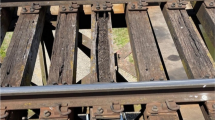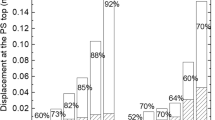Abstract
A good estimation of additional stress of a bridge approach foundation overlying embankment is of great importance in order to accurately calculate the differential settlements of foundation due to the axisymmetric distribution of the additional stress. Current design method commonly adopted in road and railway engineering in China is derived from the classical elastic theory and simply considers the embankment load by its self-weight (γh) without taking into account the influence of the width-to-height ratio. This may lead to an overestimation of additional stress and consequently an uneconomical overdesign. This study attempts to mitigate the gap by developing a new analytical solution. Based on the Boussinesq’s elastic theory, the proposed solution considers a constrained boundary condition associated with bridge abutment and incorporates a new concept of ground reaction, which takes into account the embankment load including the influence of the embankment width-to-height ratio. The proposed solution was finally validated by numerical analysis and shows a better performance in terms of additional stress estimation over the traditional calculation method. Overall, the proposed method proved to be a better alternative tool for the design of bridge approach embankment.














Similar content being viewed by others
Abbreviations
- p :
-
Subgrade reaction
- h :
-
The embankment height
- h′:
-
The equivalent height of the embankment
- \(\gamma\) :
-
The unit dry weight of the embankment soil
- \(b\) :
-
The crest width of the embankment
- b′:
-
The equivalent crest width of the embankment
- a :
-
The horizontal distance from embankment shoulder to toe
- a′:
-
The horizontal distance from embankment shoulder to toe for equivalent embankment load derived from ground reaction
- B :
-
The bottom width of the embankment
- G :
-
The deadweight of the embankment
- α1,α2,and α3 :
-
Constants that depend on the type of the foundation soil and the ratio of the embankment slope
- P :
-
The concentrated load acing on the surface of a semi-infinite space
- Z :
-
The vertical distance between the surface and the calculation point O
- R :
-
The distance between the calculation point M and the load point O
- \(\sigma_{z1}\), \(\sigma_{z2}\), \(\sigma_{z3}\) :
-
The additional stresses generated by three components of embankment load (I, II, III)
- \(\sigma_{z}\) :
-
Distribution of additional stress
- β :
-
The intersection angle between the straight line AO and the line AB
- φ :
-
Intersection angle between the straight lines AC and AB
- K f :
-
Coefficient of additional stress of foundation at the front side
- K r :
-
Coefficient of additional stress of foundation at the rear side
- δ :
-
Additional stress ratio
References
Benmebarek S, Djabri M (2017) FEM to investigate the effect of overlapping-reinforcement on the performance of back-to-back embankment bridge approaches under self-weight. Transp Geotech 11:17–26
Castro J (2015) Discussion of “column supported embankments with geosynthetic encased columns: validity of the unit cell concept”. Geotech Geol Eng 34(1):419–420
Code TB10002.5 (2005) Code for design on subsoil and foundation of railway bridge and culvert. China Railway Press, Beijing (in Chinese)
Ellis EA, Springman SM (2001) Full-height piled bridge abutments constructed on soft clay. Geotechnique 51(1):3–14
Hara T, Yu YZ, Ugai K (2004) Behaviour of piled bridge abutments on soft ground: a design method proposal based on 2D elasto-plastic-consolidation coupled FEM. Comput Geotech 31:339–355
Huang XM (2007) Cover method and application technology of high-way bridge (culvert) transition. China Communications Press, Beijing
Jiang GL, Wang HL, Li AH (2009) Study on the base stresses calculation methods of high-speed railway sub-grade. Railw Eng 4:65–69
Jiang GL, Wang LW, Hang HX (2012) Numerical simulation of centrifuge model test on coupling characteristics of bridge approach. China Civ Eng J 45(8):148–157
Kelesoglu MK, Springman SM (2011) Analytical and 3D numerical modelling of full-height bridge abutments constructed on pile foundations through soft soils. Comput Geotech 38:934–948
Khodair YA, Hassiotis S (2005) Analysis of soil–pile interaction in integral abutment. Comput Geotech 32:201–209
Li DQ, Davis D (2005) Transition of railroad bridge approach. J Geotech Geoenviron Eng J 131:1392–1398
Liu HB, Kuang KC (2002) Calculation and analysis of additional stress on abutment embankment using Boussinesq’s equation. China Munic Eng 2:37–39
Liu MC, Zhu HZ, Peng WB (2011) One-dimensional consolidation analysis of viscoelastic saturated layered soft soils under multi-stage loading of bridge approach embankment. J Cent South Univ 42(4):117–1125
Parke G, Hewson N (2008) ICE manual of bridge engineering. Thomas Telford Ltd, London
Poulos HG, Davis E (1974) Elastic solutions for soil and rock mechanics. Wiley, New York
Sañudo R, Olio L, Casado JA et al (2016) Track transitions in railways: a review. Constr Build Mater 112:140–157. https://doi.org/10.1016/j.conbuildmat.2016.02.084
Wu LJ (2011) Study on the consolidation characteristics of unsaturated soils and reinforcement technology. Ph.D. thesis, Southwest Jiaotong University
Wu LJ, Jiang GL, Li AH (2015) Modified calculation of additional stress based on centrifuge model tests. J Southwest Jiaotong Univ 50(4):79–85
Yang Q, Leng WM, Deng ZW (2008) Universal calculation formula of additional stress under bridge abutment due to embankment and conical slope. Rock Soil Mech 3:833–837
Zhang LM (1999) Settlement patterns of soft soil foundations under embankment. J Can Geotech 36(4):774–781
Acknowledgements
The author would like to acknowledge the financial support from the Technological Research and Development Programs of the Ministry of Railways in China (No. 2010G003-F).
Author information
Authors and Affiliations
Corresponding author
Additional information
Publisher's Note
Springer Nature remains neutral with regard to jurisdictional claims in published maps and institutional affiliations.
Rights and permissions
About this article
Cite this article
Wu, L., Jiang, G. & Liu, X. Analytical and Numerical Analysis of Additional Stress in Foundation of Bridge Approach Embankment. Geotech Geol Eng 38, 6069–6082 (2020). https://doi.org/10.1007/s10706-020-01414-2
Received:
Accepted:
Published:
Issue Date:
DOI: https://doi.org/10.1007/s10706-020-01414-2




